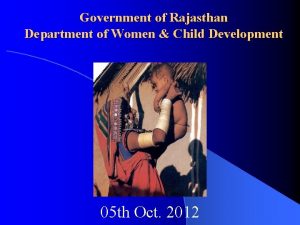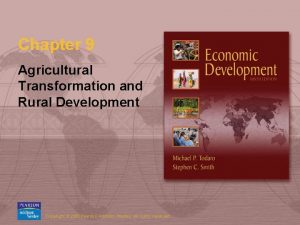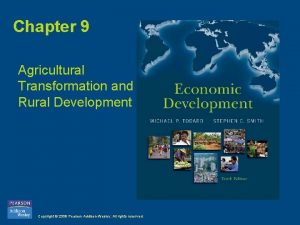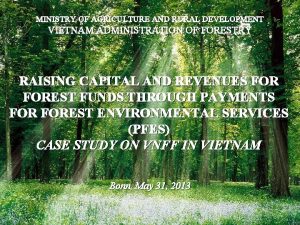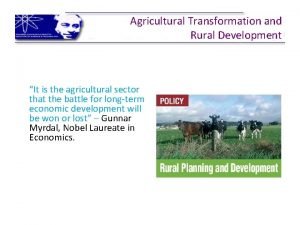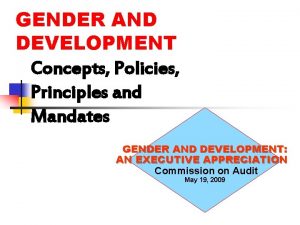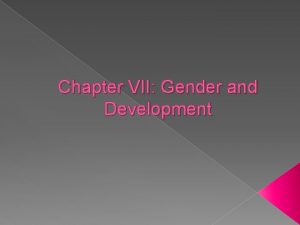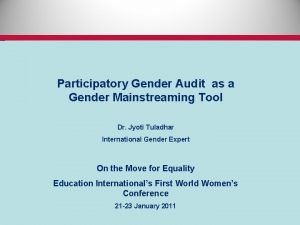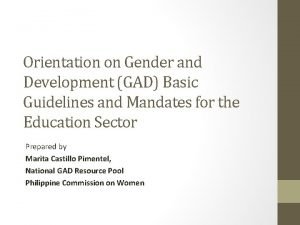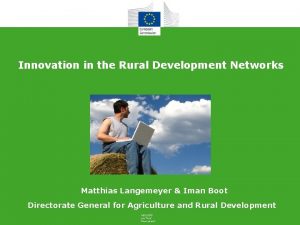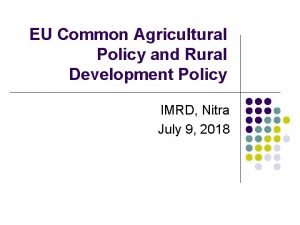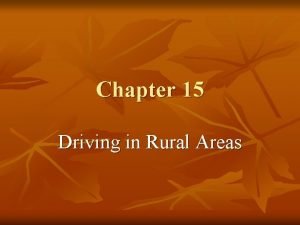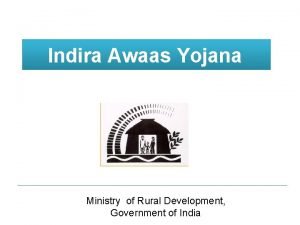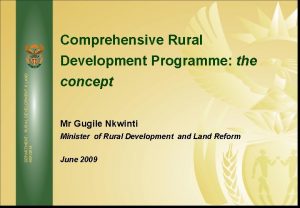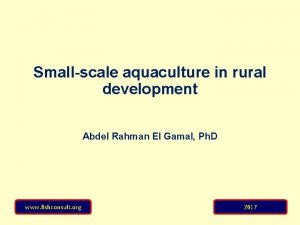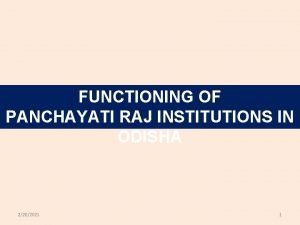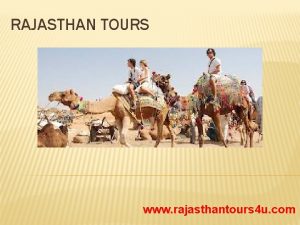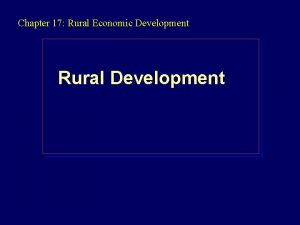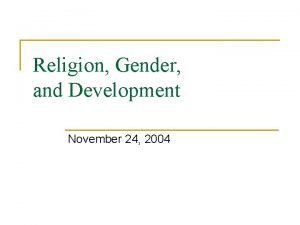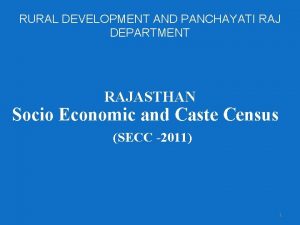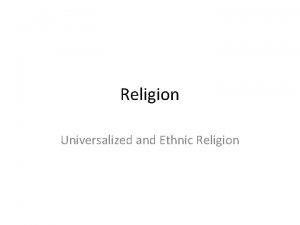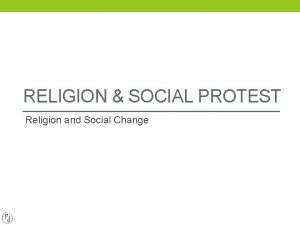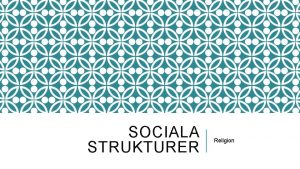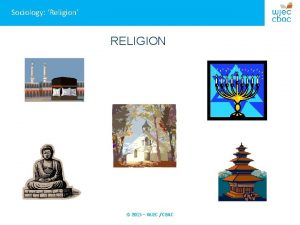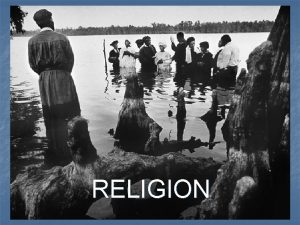Religion Gender and Development in Rural Rajasthan Dr























- Slides: 23

Religion, Gender and Development in Rural Rajasthan Dr Tamsin Bradley London Metropolitan University

In this lecture I will do five things: Give an overview of current approaches to gender and development. Why are Third World women considered victims? Masculinities in Rajasthan Present 3 case studies of Rajasthani women showing how religion forms a vital part of their lives. Show micro case studies could help to better inform the work of NGOs.

Some key terms defined: NGO: Non-governmental Organisation Feminism: A political ideology that argues women have been systematically marginalised from public life by a system called patriarchy. Patriarchy: literally means rule of the father and denotes a system that privileges men. Gender: A category of analysis that examines the relationship between men and women and considers how this relationship impacts on the roles and expectations placed on each sex.

At its core Gender and Development (GAD) highlights how women have been ignored by development initiatives

The Emergence of Gender and Development (GAD) Recognising Women’s Economic Contribution Esther Boserup ground-breaking work Women’s Role in Economic Development (1970) sparked questions about the nature of development The fundamental point made by Boserup was that women’s contribution to household income has been constantly underestimated and ignored. Boserup also draws attention to the importance of women's domestic labour to the economy of the wider community. Boserup wanted women’s actual contribution to be recognised by researchers. She also wanted women to commercialise their activities e. g. by selling the vegetables they grow at market.

Women in Development (WID The body of research resulting from Boserup’s book helped set the agenda for the National Decade for Women (1976 -85). The primary objective of the decade was to achieve the equitable integration of women in economic development. WID emerged and was supported by donor agencies who directed money specifically to projects designed to improve women's economic standard of living.

Problems with WID practitioners avoided examining the nature and root causes of female subordination. Without identifying the processes that constrain women’s development, any project aimed at achieving equal rights for women will have only limited success. What is not fully appreciated by WID planners is the extent to which women are already stretched.

Women and Development (WAD) On a theoretical level, WAD is able to account for the impact of class in determining a woman’s access to economic production. Faced same practical problems as WID, unable to find a way of challenging structural root of women’s inequalities.

Gender and Development (GAD) In the 1980 s, the Gender and Development (GAD) approach emerged as an alternative to WID and WAD. GAD attempts to answer the question: why are women assigned secondary roles in so many societies? According to GAD, the greatest degree of female subordination occurs in the private sphere, where women come under the direct control of their fathers or husbands. The final objective of GAD is to achieve a shift in power relations that will give women greater autonomy. Initiatives designed through this GAD perspective often hold the objective of empowering women.

Practically WID/WAD still shape projects The majority of projects find their roots in WID and WAD, both of which are grounded in a Basic Needs Approach (BNA) to development. List of basic needs: a change in traditional attitudes, greater access to education, better primary health care facilities and implementation of time saving strategies, the availability of credit schemes, legal equality and improved land rights = greater economic independence.

Problem: There is clearly a gap between theory and practice. This gap limits the effectiveness of projects in their efforts to improve standards of living for men and women.

The Desire to see a ‘Transformation’ in the Lives of Third World Women The concern for economic independence reflects a western model for development. Western feminist concerns are being transferred to women in the Developing World. The assumption implicit in this approach is that all women desire the same existence. But do they?

NGO campaign image Imagine a little girl, watching her mother struggle to carry heavy pots of water home many miles from the well every day, seeing her eat only what is left over after the men of the family have eaten. . . She knows that the confinement of the house and the endless chores she helps with will be her lot in the future.

Women as Victims Are women victims of an oppressive system of they cannot resist? Feminist anthropologists state that women are not passive but active agents. Bargaining: more likely that women negotiate better deals for themselves. Resistance: challenging structures that oppress. Power and status comes with age.

Why is an accurate picture needed? If we do not understand the lives of those we wish to help how can we bring effective change? Damage can be done by those well meaning NGOs who wish to help but base their actions on misconceptions and stereotypes.

Backlash Increase in violence against women. NGOs prioritise women for jobs. Men have to migrate in search of work. Increase in alcoholism resulting in male violence directed at women who are blamed for taking male roles.

Masculinities in Rajasthan case 1 Man One: Rajput upper caste man born into a wealthy land owning family. He lives with his joint family on the outskirts of Dudu (Jaipur Dudu). He has five children (three boys, two girls). Living: He has set up a private water company and is able to prosper at a time of drought by selling water to villagers. Religion: Rama is the dominant religious image in this region. He is perceived as a strong ruler who is in control of his wife’s sexuality. He protects and provides. Mother and Father: described as being strong and defiant. She is thought of as being very supportive, preserving her son’s authority. The father is projected as the patriarchal role model. Wife: His wife as a Rajput women observes strict purdah and rarely leaves the home. Her duties are domestic and reproductive. In public she will keep her face veiled and will not speak to men outside of her family. Male Authority: Will become violent if he feels his authority is being threatened. His aggression is often directed at his wife. Alcohol will heighten this aggression. Drinking is often done with other men at a public drinking stand. This moment of male interaction can often turn aggressive.

Masculinities in Rajasthan case 2 Background: A low caste (kumhar or potter) man who lives in a village called Korsina thirty Kilometres from the nearest town (Dudu). He lives with his joint family, wife and three children (one boy and two girls). Living: He is unable to generate an income as a potter at present because of the impact of the drought he migrates periodically in search of work. Mother Father: Defiant strong influence on his life. He saw his mother struggle to cope with keeping the family together during a previous period of drought when his father and other men had to migrate for work. He began to train as an apprentice potter under his father at eight. Wife: His wife works outside the home as a labourer (de silting ponds, agricultural work). This is due to economic necessity rather than preference. Male Authority: Expressed feelings of acute disempowerment due to experiences of poverty. Feels unable to fulfil role as the provider and has to watch his wife do so instead. Although he migrates in search of work he is unable to earn enough to send home, this increases his sense of failure as he returns with nothing. Drinks while away and with any money he has when at home this transforms his depression into violent outbursts directed at his wife.

Section 2: My Ethnographic Case Studies

Case studies – 3 stories Case Study One: Poonam Case Study Two: Parvati Case Study Three: Devi

Interpretations of Sita Feminists claim she is oppressive. Coping strategy? To help make sense of a ‘collective history of suffering? Creation of bonds, shared experience.

Section 3: How might NGOs utilise religious spaces in their project planning and implementation? The image I gained of Rajasthani women was very different from the image projected by the western donor NGO. Religious spaces offer development workers the chance to gain more insightful perceptions of people. Furthermore by tracking changes in religious practices it is possible to understand shifts in peoples’ life priorities and perceptions of their environment.

Conclusion Key questions/ issues raised in my research The need for NGOs to gain a closer understanding of those they wish to help. Religion has been largely ignored by the development industry but is in fact a useful tool in helping NGOs achieve closer and more constructive relationships with their ‘target groups’. The importance of dialogue between the givers and receivers of aid.
 Women and child development - government of rajasthan
Women and child development - government of rajasthan Strategic gender needs and practical gender needs
Strategic gender needs and practical gender needs Secneer
Secneer Chapter 9 agricultural transformation and rural development
Chapter 9 agricultural transformation and rural development Chapter 9 agricultural transformation and rural development
Chapter 9 agricultural transformation and rural development Ministry of agriculture and rural development cameroon
Ministry of agriculture and rural development cameroon Ecotourim
Ecotourim Agricultural transformation and rural development
Agricultural transformation and rural development Gad objectives
Gad objectives Objectives of gender and development
Objectives of gender and development Gender and development
Gender and development Gender and development
Gender and development Sample lesson plan in gender and development
Sample lesson plan in gender and development Matthias langemeyer
Matthias langemeyer Rural development
Rural development Rural areas have of development drivers ed
Rural areas have of development drivers ed Usda rural development tifton ga
Usda rural development tifton ga Ministry of rural development
Ministry of rural development Ministry of rural development
Ministry of rural development Comprehensive rural development programme
Comprehensive rural development programme Conclusion of rural development
Conclusion of rural development Pesa act 1996
Pesa act 1996 Rural development loan massachusetts
Rural development loan massachusetts Dpip rajasthan
Dpip rajasthan
